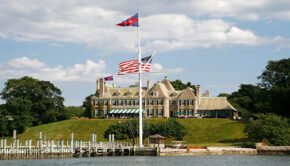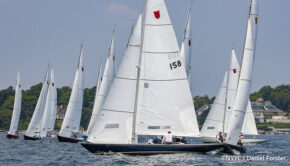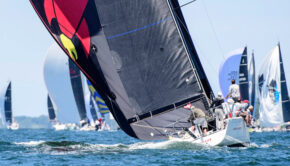All eyes on 165th Annual Regatta
Published on June 11th, 2019
The return of the Swan American Regatta and the inaugural season of racing in the new Melges IC37 fleet are two of the many reasons why the 165th edition of the New York Yacht Club Annual Regatta is seeing a significant upswing in entries.
With just shy of 150 entries, and a few days still remaining until the first gun, this year’s running of North America’s oldest regular sailing competition will be one of the biggest in history. The 2019 edition will run June 14 to 16 out of the New York Yacht Club Harbour Court in Newport, R.I.
All classes will enjoy the traditional race around Conanicut Island on Friday, June 14, followed by two days of buoy and navigator racing over the weekend for PHRF, IRC, and one-designs, along with the Swans which will compete under the ORC handicap rule.
For New England sailors eager to shake off a long winter—and in this case, an inclement spring—the Annual Regatta is always a great way to kick off the Newport sailing season.
“The past decade has seen a lot of skippers shift from larger raceboats to smaller one-designs, such as the J/70 and Melges 20,” says event chair David Bush-Brown. “It would’ve been easy to add those fleets to the Annual Regatta and see our numbers approach 200 entries, but the Club preferred to keep this event focused on boats at least 25 feet long.
“Those small boats will get their time in the limelight at the One-Design Regatta in late June. It’s very encouraging to see such a strong entry list for the Annual Regatta. The Club runs many events each summer, but none can match the Annual Regatta’s history and tradition.”
The Swan American Regatta was a biennial staple of the East Coast sailing circuit until a decade ago when a favorable Euro exchange rate led to a lot of United States-based Swans being sold to European owners.
However, the number of Swans sailing domestically has crept back up in recent years, so this summer two of sailing’s iconic brands, the New York Yacht Club and Nautor’s Swan, are pairing up to put this popular event back on the schedule.
Among the 12 entries in the Swan division is White Rhino, a Swan 56 skippered by Todd Stuart (Key West, Fla.). Stuart and his crew are one of the more active teams in the region. But, of late, they’ve spent more time racing his Carkeek 47 White Rhino 2, a stripped-out custom raceboat.
“We have done [Swan-only events] twice in the BVI and enjoyed it very much,” said Stuart. “My wife and I were very saddened by the destruction of the beautiful Yacht Club Costa Smeralda Virgin Gorda by Hurricane Irma.
“When they moved the event to our summer home of Newport and our yacht club’s Annual Regatta, we felt strongly about participating. We love the Swan brand and wanted one long before we purchased ours in 2005.”
The Swan 56 is one of the company’s more successful designs with 46 built between 1997 and 2006. History has also proven it to be one of the company’s best performers on the racecourse.
“In my opinion the Swan 56 is one of the finest racer/cruisers ever built,” says Stuart. “We have generally sailed the boat to its rating, although this year will be our first event under the ORCi rating system. We’ll have to see how that works out. As always, our strategy will be to sail our own race, be safe, have fun, and hopefully be on the podium at the end of the event.”
The class of 12 boats ranges in age and size from Chris Otorowski’s Swan 39, which was built in 1979, to Gibb Kane’s Swan 66, which is just hitting its 10th birthday. But the design ethos behind the brand has remained constant since the first Swan was launched more than 50 years ago, and the boats share many key characteristics in terms of performance. Once the handicaps are applied, the racing is likely to be very competitive.
The same is true of the Melges IC37 fleet, which will see its first real racing action during the Annual Regatta. But in this case, the boats won’t need any handicap rule. The Melges IC37 may be the strictest one-design of its size ever created. Not only are the hulls and equipment the same, but the sails all come from the same design and manufacturer and the standing rigging is locked down.
This turn-key racing concept was hatched two years ago by the New York Yacht Club with dual goals of supporting the Club’s flagship event, the Rolex New York Yacht Club Invitational Cup, and Corinthian competition in a larger one-design. The Club-owned fleet of 20 boats has been chartered to members for the season. Privately-owned boats will join the fleet later this summer.
“There has been a lot of positive ‘anticipation’, so one is always concerned that we meet expectations,” says class president Phil Lotz, who announced the project to the membership two years ago, during his term as Commodore of the New York Yacht Club.
“Given all the feedback I have heard, directly and indirectly, we have met and exceeded expectations. What is equally rewarding is seeing all the younger sailors, both male and female, getting together as teams and then afterwards socializing. You need to have a great on-the-water program, but success will be driven by the off-the-water experience.”
Two consecutive weekends of practice racing have helped the fleet climb a very steep learning curve. Lotz, who was instrumental in the development of the Swan 42 class a decade ago, expects a very competitive series this coming weekend.
“I foresee six different race winners in an eight-race regatta,” he says. “It will be interesting to see what the winner’s average points turn out to be. With no throw-out races, and very even boats, consistency is a major goal.”
That mantra will apply across the regatta, from the IC37s to the 100-year-old S boats. With large fleets and a lot of sailors eager to start the season off on the right foot, consistency at the 165th edition of the New York Yacht Club Annual Regatta will be both very desirable and very challenging to achieve.
Event information – Regatta details – Entry list – Facebook
Source: Stuart Streuli









 We’ll keep your information safe.
We’ll keep your information safe.